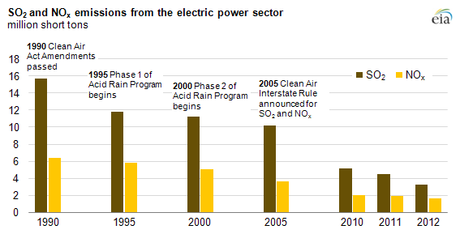
Source: U.S. Environmental Protection Agency, Clean Air Markets Division
Sulfur dioxide (SO2) and nitrogen dioxide (Nox) emissions from power plants last year have dropped to a minimum level since the passage of the Clean Air Act Amendments of 1990. This decrease in pollution is most likely due to a large number of coal plants retrofitted with flue-gas desulfurization (FGD), or scrubbers, switching to lower sulfur coal, and to selective catalytic reduction (SCRs), selective noncatalytic reduction (SNCR), or low NOx burners to limit NOx emissions. Substitution of coal by cheaper and cleaner natural gas in power generation have also had its role in the emissions decline.
The decline in SO2 and NOx emissions began soon after enactment of the 1990 Clean Air Act Amendments, which established a national cap-and-trade program for SO2 and required other controls for NOx emissions from fossil-fueled electric power plants. The program was primarily motivated by concerns regarding acid rain affecting areas downwind of plants emitting these compounds. Because coal-fired units accounted for a large share of SO2 and NOx emissions, the program provided an economic incentive for coal-fired power plants to reduce emissions by installing pollution control systems, burning lower sulfur coal, or, for high-emitting plants, dispatching less electricity.
In 2005, EPA developed the Clean Air Interstate Rule, a cap-and-trade program intended to reduce SO2 and NOx emissions beyond the levels defined by the acid rain program in the eastern half of the United States. While that rule and several proposed alternatives have been challenged in the courts, 91 GW of coal-fired power capacity was retrofitted with FGD scrubbers between 2005 and 2011. By the end of 2011, 60% of the U.S. coal fleet had FGD scrubbers installed, and 67% had either a SCR or a SNCR installed.
Additional state requirements and settlements under the Clean Air Act’s New Source Review program also contributed to the increases in coal plant environmental retrofits. The Mercury and Air Toxics Standards, issued in 2011 and set to take effect in 2015, do not directly regulate SO2 or NOx but the standards should lead coal-fired power plants to install equipment that further limits SO2 emissions.
The reduction in SO2 and NOx emissions through the late 2000s was primarily the result of coal plants employing strategies to reduce emissions, not a reduction in the use of coal overall. In fact, coal generation set record highs in 2007 when significant SO2 reduction was already underway. Two major contributors of declining SO2 and NOx emissions since late 2008 have been:
• Lower overall generation from coal in 2012
• Historically low natural gas prices, which have contributed to shifting some generation from coal to natural gas

